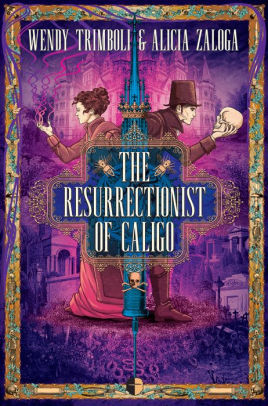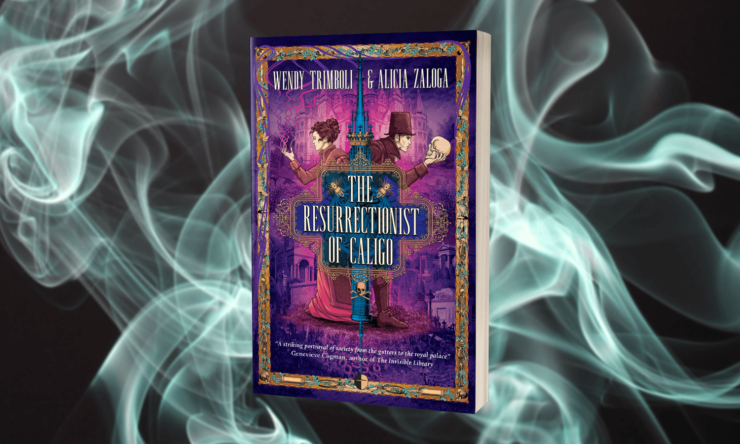The book begins in a suitably disconcerting setting: a Victorian-style graveyard in the mysterious city of Caligo. A young man, Roger X. Weathersby, is stalking the dead. Roger is the titular Resurrectionist—a grave-robber who seeks out just-barely-cold bodies to sell to institutions of science and learning. Caligo is made up of a fictional London mixed with a dash of New Orleans houdou, a blend of deeply ingrained classist institutions and social ranks mixing alongside a royal pantheon of blueblood sorcerers, all said to be descended from… a selkie?
Well, if we’re going to go there, I suppose we should go there. The book has a huge amount of lore stuffed into its pages, and it seems like each chapter introduces a new royal connection, magical ability, cultural critique, or social norm. The mythology of the world is expansive, and the strange magical gifts are both bizarre and unexplained, in a way that most strange things become if you live alongside them long enough. Our second main character, one Princess Sibylla of Myrcnia, has magical gifts include bioluminesce on command and when aroused, a whistle-click that can deafen anyone nearby, and, most prominently, the ability to generate ink and control its movement in the world, making letter-writing and map-making extremely easy. Besides this, there are neighboring empires we learn about, visiting dignitaries and ambassadors, and bizarre rituals of binding murderers to royalty through daily blood consumption. The main plot of the book is slightly lost amid all the worldbuilding, with each chapter only briefly mentioning the storyline promised on the back cover.
The two main characters in this sweeping Victorian urban fantasy are the Resurrectionist and self-styled “Man of Science,” Roger Weathersby, and the princess sixth in line to the throne of Caligo, Sibylla. Roger is the first to suspect a murderer haunting the streets of Caligo, but instead of reporting this discover to the police, he does some sleuthing of his own, recording evidence found within whorehouses and coffins. Sibylla doesn’t know of anything amiss in Caligo for at least half the book, but once she does realize there is unrest, she is swept up in royal politics and fails to make meaningful gains towards the mystery until the last quarter of the book, where many things seem to come together all at once.
The binding ritual described as one of the main plots fails to materialize as a source of tension for both characters until the last quarter of the book. Roger and Sibylla have a rocky history together, starting when both were in their teens and making out in dusty corners of the royal palace. With most communication between the two alternating Point of View characters occurring via letter or through an intermediary, the miscommunications between Roger and Sibylla feel incidental rather than purposeful. There’s a layer of secrecy surrounding the ritual in the fiction which makes the misunderstandings between Roger and Sibylla feel as if everything could be easily avoided if the two main characters could just be in a room together. There are not enough interactions between the two of them to drive the plot forward, and while the two co-authors masterfully interweave explorations of Caligo neighborhoods with large-scale worldbuilding, the characterization of both Roger and Sibylla fall flat.
It is mostly because of this distance from each other throughout the entire book that makes the dynamic of Roger and Sybylla seem forced. They are charming enough, but the world they occupy and the circles they travel in make for much more interesting companions. The exclusive Anathema Club of scientists and doctors, where Roger experiences a high from literal magic mushrooms (where they come from is of no importance, although the reveal at the end of the book may make you queasy), is full of utterly fascinating set design and decisions. I wish that Roger had used his skills for breaking and entering into crypts to steal a few more scenes in the club. Likewise, the grotto where Sibylla finds her prayer-portrait hung provides more intriguing questions than answers.
Buy the Book


The Resurrectionist of Caligo
The Resurrectionist of Caligo plays with genre in an intriguing and clever way. There are horror elements mixed with fantasy, colonial critique, and class commentary, all blended into a book that is a pleasure to read. The tension waxes and wanes evenly with the different character chapters, and I didn’t feel that any part of the book failed to add something new to the world. The layers of lore were expertly built, giving us just enough to want more from the next chapter. The side characters were deftly rendered, and I found myself more interested in the goals of minor players than Princess Sibylla.
The social commentary of the novel also has its ebb and flow. Roger is the character with truly identifiable goals, as a young man who wishes to study to become a surgeon but can’t afford the (social and monetary) class fee of entry. Caligo doesn’t allow for women to study, but the neighboring country of Khalishkha, which is coded as exotic and slightly barbaric in the first part of the novel, has educated women. Our brief encounters with the female Doctor in the book are just enough to establish Caligo as a more backward country than previously implied. This sexism is spread liberally through the book, with more than one whorehouse playing an important role in the plot. The authors do take steps to create dramatic irony, casting men as villains and propagators of a system that serves as their undoing later in the novel, but the narrative’s commitment to casual acts of historical sexism and the continued mistreatment of women and their agency can be overwhelming. The points of men’s comeuppance are truly cheer-worthy, but the journey to get there is, at times, difficult to read.
Ultimately, the great parts of The Resurrectionist of Caligo are truly great. The world and its inhabitants, social structures, and bizarre monarchy are just enough for me to believe that they are, in some ways, archaic remnants of a much deeper history that is not revealed in the book. There are hints of explanation; a great plague that occurred when doctors meddle with magic and science, an underground cohort of women who are magically inclined but not of royal blood, the veneration of royalty via consecrated chapels and grottos where portraits are hung in supplication. The mythos of Resurrectionist creates a rich world full of intrigue and history that is utterly engaging and immersive, and the fantasy landscape of Myrcnia is the real reason to pick up this book.
The Resurrectionist of Caligo is available from Angry Robot Books.
Linda H. Codega is a queer, nonbinary writer and author living in a mountain in the Hudson Valley. They are a current editor for Luna Station Quarterly and their short stories have been published in SFF zines, including Helios Quarterly and the anthology “Pioneers and Pathfinders.” Inspired by magical realism and speculative fiction, their work often comments on climate change, pop culture, and social justice.










